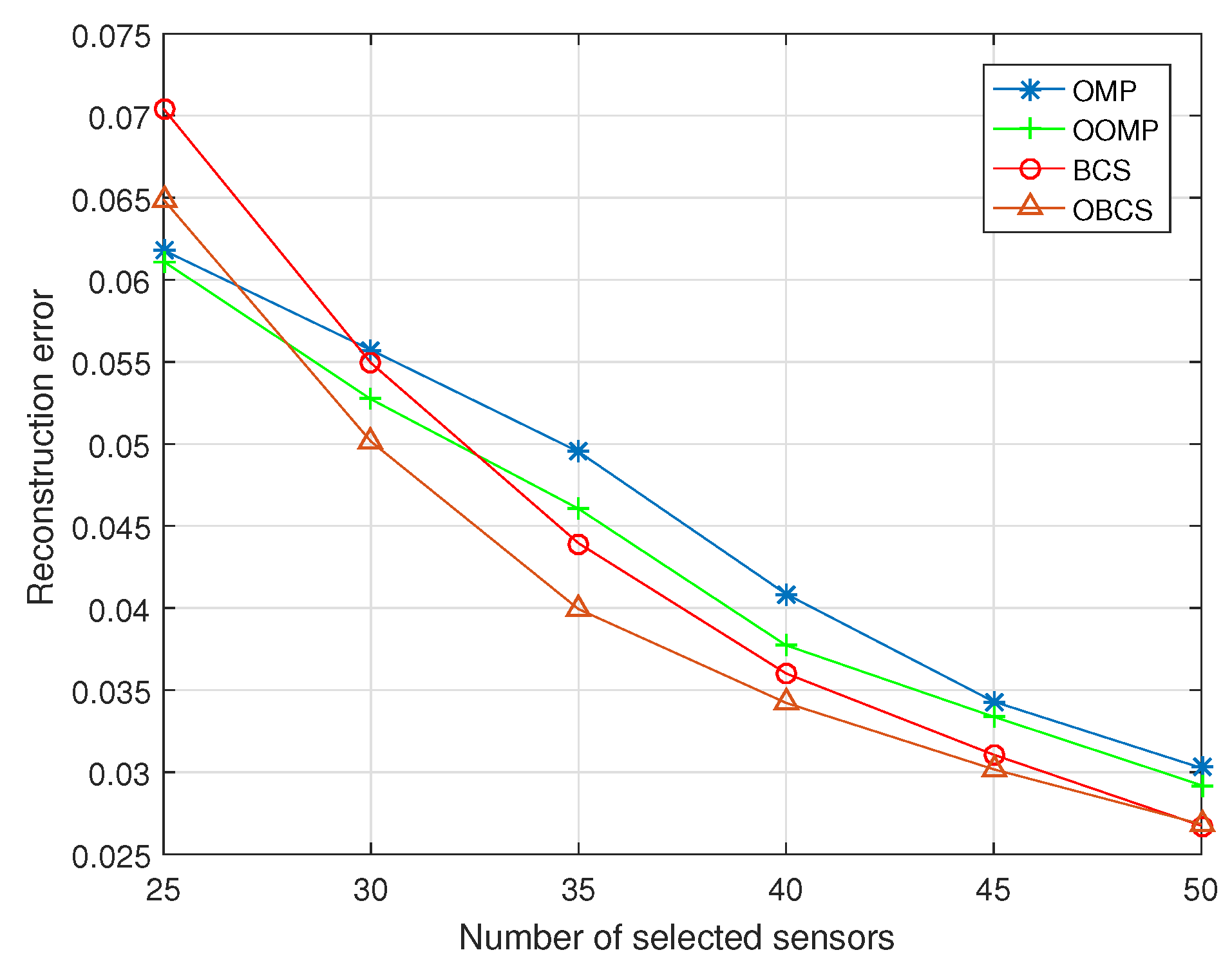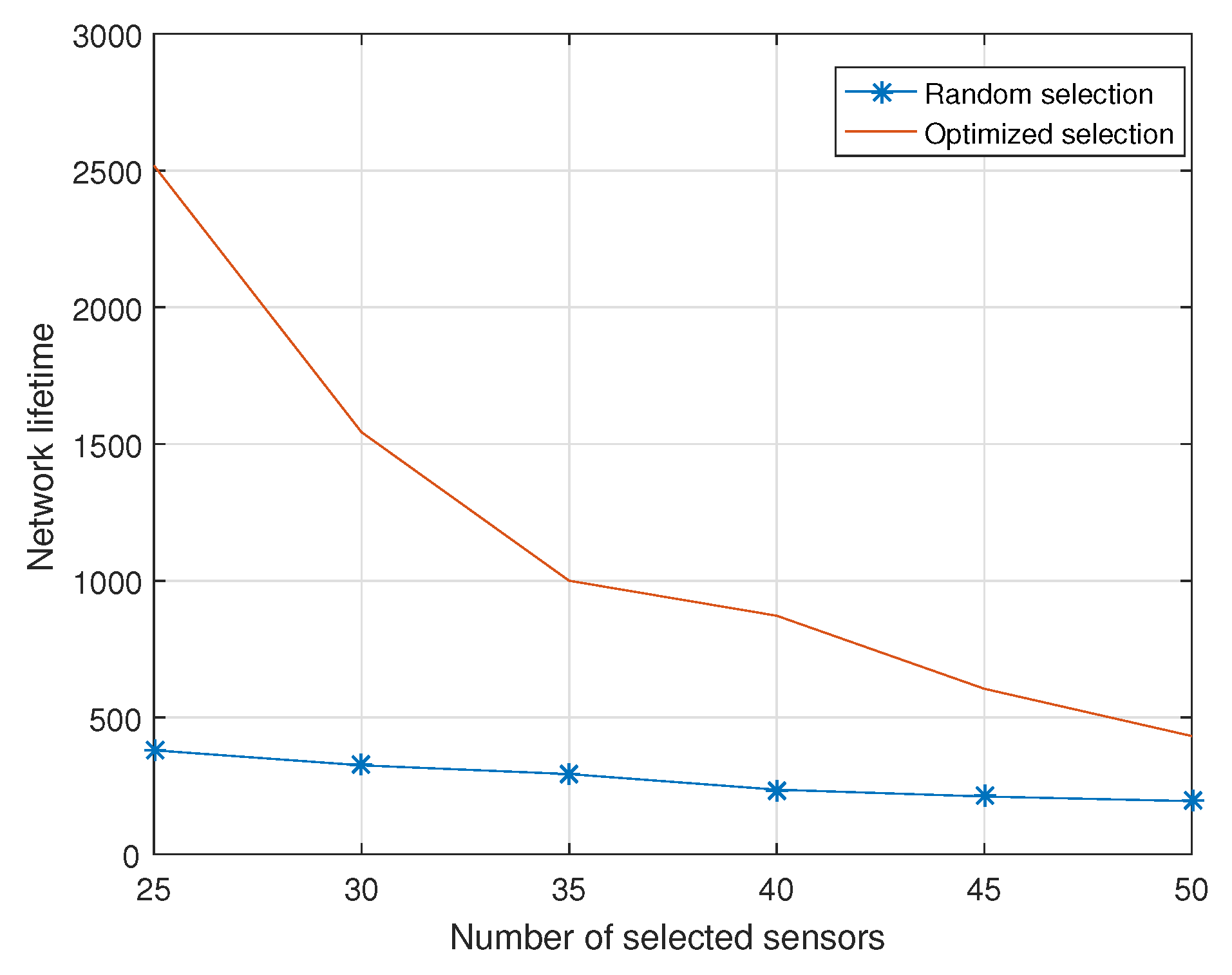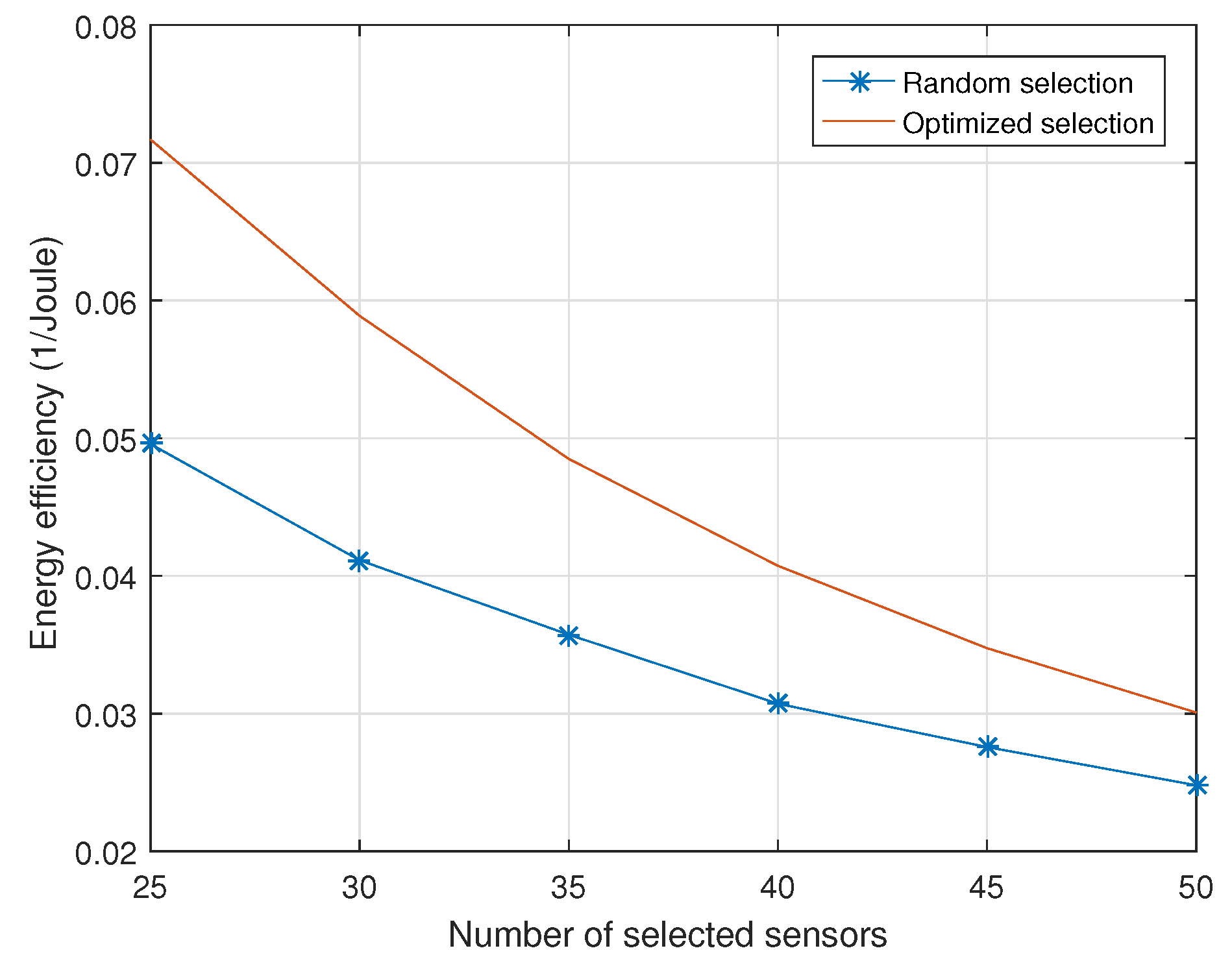Bayesian Compressive Sensing Based Optimized Node Selection Scheme in Underwater Sensor Networks
Abstract
:1. Introduction
1.1. Related Works and Motivation
1.2. Contributions
- The paper focuses on the improvement of performance of a compressed sensing scheme. First, a Bayesian estimation theory is provided for the signal reconstruction. Then, based on Bayesian estimation theory, the closed-form expression of posterior density function and error covariance matrix are given. By a maximum posteriori estimation, the noise variance can be obtained by updating iteratively.
- The sensor node selection scheme is transformed as a sensing matrix design problem. By using the error covariance matrix of Bayesian estimation and regarding the sensing matrix as a variable, the sensing matrix design problem can be treated as an optimization problem of minimizing the MSE. Because the proposed optimization problem is non-convex, the optimal solution is difficult to obtain. By relaxing the integer constraint as a continuous constraint, the proposed optimization problem becomes a convex semidefinite programming problem that can be solved efficiently.
- The sustainability of networks is considered in the proposed optimization problem. To prolong the network lifetime, the scheme aims at selecting the sensor nodes holding more residual energy. This idea is transformed into a constraint in the optimization problem.
1.3. Paper Organization
1.4. Notation
2. System Model and Problem Formulation
2.1. System Model
2.2. Bayesian Compressive Sensing
| Algorithm 1 Expectation maximization algorithm for Bayesian estimation [35]. |
|
2.3. Underwater Channel Model
3. Optimized Node Selection Scheme
3.1. Scheme for Minimizing MSE of Estimation
3.2. Scheme for Prolonging the Network Lifetime
| Algorithm 2 Optimized node selection algorithm based on convex relaxation. |
|
4. Simulation Results and Discussion
5. Conclusions
Author Contributions
Funding
Conflicts of Interest
Abbreviations
| NP | Non-deterministic polynomial |
| CSI | Channel state information |
| MSE | Mean square error |
| EM | Expectation maximization |
| OMP | Orthogonal matching pursuit |
| OOMP | OMP algorithm with optimized sensor nodes selection scheme |
| BCS | Bayesian compression sensing estimation |
| OBCS | Bayesian compression sensing estimation with optimized sensor nodes selection scheme |
Appendix A
References
- Zhu, C.S.; Shu, L.; Leung, V.C.M.; Guo, S.; Zhang, Y.; Yang, L.T. Secure multimedia big data in trust-assisted sensor-cloud for smart city. IEEE Commun. Mag. 2017, 55, 24–30. [Google Scholar] [CrossRef]
- Zhu, C.S.; Wang, H.; Liu, X.L.; Shu, L.; Yang, L.T.; Leung, V.C.M. A novel sensory data processing framework to integrate sensor networks with mobile cloud. IEEE Syst. J. 2016, 10, 1125–1136. [Google Scholar] [CrossRef]
- Han, Y.F.; Zhang, J.C.; Sun, D.J. Error control and adjustment method for underwater wireless sensor network localization. Appl. Acoust. 2018, 130, 293–299. [Google Scholar] [CrossRef]
- Zhang, J.R.; Xia, Z.X.; Huang, L.Y.; Ma, L.K. Experimental and numerical parametric studies on two-Phase underwater ramjet. J. Propuls. Power 2018, 34, 161–169. [Google Scholar] [CrossRef]
- Sun, F.F.; Liu, W.; Dong, Z.X.; Deng, Y.L. Underwater superoleophobicity cellulose nanofibril aerogel through regioselective sulfonation for oil/water separation. Chem. Eng. J. 2017, 330, 774–782. [Google Scholar] [CrossRef]
- Wang, C.; Yu, H.Y.; Zhu, Y.J.; Wang, T. Blind detection for SPAD-based underwater VLC system under P-G mixed noise model. IEEE Commun. Lett. 2017, 21, 2602–2605. [Google Scholar] [CrossRef]
- Han, G.J.; Jiang, J.F.; Bao, N.; Wan, L.T.; Guizani, M. Routing protocols for underwater wireless sensor networks. IEEE Commun. Mag. 2015, 53, 72–78. [Google Scholar] [CrossRef]
- Han, G.J.; Jiang, J.F.; Sun, N.; Shu, L. Secure communication for underwater acoustic sensor networks. IEEE Commun. Mag. 2015, 53, 54–60. [Google Scholar] [CrossRef]
- Zhu, C.S.; Li, X.H.; Leung, V.C.M.; Yang, L.T. Towards pricing for sensor-cloud. IEEE Trans. Cloud Comput. 2017. [Google Scholar] [CrossRef]
- Zhu, C.S.; Leung, V.C.M.; Wang, K.; Yang, L.T.; Zhang, Y. Multi-method data delivery for green sensor-cloud. IEEE Commun. Mag. 2017, 55, 176–182. [Google Scholar] [CrossRef]
- Li, S.C.; Xu, L.D.; Wang, X.H. Compressed sensing signal and data acquisition in wireless sensor networks and internet of things. IEEE Trans. Ind. Inform. 2013, 9, 2177–2186. [Google Scholar] [CrossRef]
- Do, T.T.; Gan, L.; Nguyen, N.H.; Tran, T.D. Fast and efficient compressive sensing using structurally random matrices. IEEE Trans. Signal Process. 2012, 60, 139–154. [Google Scholar] [CrossRef]
- Duarte, M.F.; Eldar, Y.C. Structured compressed sensing: From theory to applications. IEEE Trans. Signal Process. 2011, 59, 4053–4085. [Google Scholar] [CrossRef]
- Bayati, M.; Montanari, A. The dynamics of message passing on dense graphs, with applications to compressed sensing. IEEE Trans. Inf. Theory 2011, 57, 764–785. [Google Scholar] [CrossRef]
- Adcock, B.; Hansen, A.C. Generalized sampling and infinite-dimensional compressed sensing. Found. Comput. Math. 2016, 16, 1263–1323. [Google Scholar] [CrossRef]
- Bajwa, W.U.; Haupt, J.; Sayeed, A.M.; Nowak, R. Compressed channel sensing: A new approach to estimating sparse multipath channels. Proc. IEEE 2010, 98, 1058–1076. [Google Scholar] [CrossRef]
- Haupt, J.; Bajwa, W.U.; Raz, G.; Nowak, R. Toeplitz compressed sensing matrices with applications to sparse channel estimation. IEEE Trans. Inf. Theory 2010, 56, 5862–5875. [Google Scholar] [CrossRef]
- Carlin, M.; Rocca, P.; Oliveri, G.; Viani, F.; Massa, A. Directions-of-arrival estimation through Bayesian compressive sensing strategies. IEEE Trans. Antennas Propag. 2013, 61, 3828–3838. [Google Scholar] [CrossRef]
- Lustig, M.; Donoho, D.; Pauly, J.M. Sparse MRI: The application of compressed sensing for rapid MR imaging. Magn. Reson. Med. 2007, 58, 1182–1195. [Google Scholar] [CrossRef] [PubMed] [Green Version]
- Yang, L.; Song, K.; Siu, Y.M. Iterative clipping noise recovery of OFDM signals based on compressed sensing. IEEE Trans. Broadcast. 2017, 63, 706–713. [Google Scholar] [CrossRef]
- Bevacqua, M.T.; Crocco, L.; Di Donato, L.; Isernia, T. Non-linear inverse scattering via sparsity regularized contrast source inversion. IEEE Trans. Comput. Imaging 2017, 3, 296–304. [Google Scholar] [CrossRef]
- Bevacqua, M.T.; Isernia, T. Shape reconstruction via equivalence principles, constrained inverse source problems and sparsity promotion. Prog. Electromagn. Res. 2017, 158, 37–48. [Google Scholar] [CrossRef]
- Bevacqua, M.T.; Scapaticci, R. A compressive sensing approach for 3D breast cancer microwave imaging with magnetic nanoparticles as contrast agent. IEEE Trans. Med. Imaging 2016, 35, 665–673. [Google Scholar] [CrossRef] [PubMed]
- Sung, C.K.; de Hoog, F.; Chen, Z.; Cheng, P.; Popescu, D.C. Interference mitigation based on Bayesian compressive sensing for wireless localization systems in unlicensed band. IEEE Trans. Veh. Technol. 2017, 66, 7038–7049. [Google Scholar] [CrossRef]
- Gu, X.J.; Zhou, P.; Gu, X.S. Bayesian compressive sensing for thermal imagery using Gaussian-Jeffreys prior. Infrared Phys. Technol. 2017, 83, 51–61. [Google Scholar] [CrossRef]
- Hawes, M.; Mihaylova, L.; Septier, F.; Godsill, S. Bayesian compressive sensing approaches for direction of arrival estimation with mutual coupling effects. IEEE Trans. Antennas Propag. 2017, 65, 1357–1368. [Google Scholar] [CrossRef]
- Ding, W.B.; Lu, Y.; Yang, F.; Dai, W.; Li, P.; Liu, S.C.; Song, J. Spectrally efficient CSI acquisition for power line communications: A Bayesian compressive sensing perspective. IEEE J. Sel. Areas Commun. 2016, 34, 2022–2032. [Google Scholar] [CrossRef]
- Tipping, M.E. Sparse Bayesian learning and the relevance vector machine. J. Mach. Learn. Res. 2001, 1, 211–244. [Google Scholar]
- Ozgor, M.; Erkucuk, S.; Cirpan, H.A. Bayesian compressive sensing for ultra-wideband channel estimation: Algorithm and performance analysis. Telecommun. Syst. 2015, 59, 417–427. [Google Scholar] [CrossRef]
- Yu, F.Y.; Li, D.Z.; Guo, Q.; Wang, Z.Y.; Xiang, W. Block-FFT based OMP for compressed channel estimation in underwater acoustic communications. IEEE Commun. Lett. 2015, 19, 1937–1940. [Google Scholar] [CrossRef]
- Fazel, F.; Fazel, M.; Stojanovic, M. Random access compressed sensing for energy-efficient underwater sensor networks. IEEE J. Sel. Areas Commun. 2011, 29, 1660–1670. [Google Scholar] [CrossRef]
- Lin, H.Z.; Wei, W.; Zhao, P.; Ma, X.Q.; Zhang, R.; Liu, W.P.; Deng, T.P.; Peng, K. Energy-efficient compressed data aggregation in underwater acoustic sensor networks. Wirel. Netw. 2016, 22, 1985–1997. [Google Scholar] [CrossRef]
- Yan, H.C.; Xu, J.; Long, T.; Zhang, X.D. Underwater acoustic matched field imaging based on compressed sensing. Sensors 2015, 15, 25577–25591. [Google Scholar] [CrossRef] [PubMed]
- Cheung, B.C.; Carriveau, R.; Ting, D.S.K. Parameters affecting scalable underwater compressed air energy storage. Appl. Energy 2014, 134, 239–247. [Google Scholar] [CrossRef]
- Huang, K.D.; Guo, Y.; Guo, X.M.; Wang, G.L. Heterogeneous Bayesian compressive sensing for sparse signal recovery. IET Signal Process. 2014, 8, 1009–1017. [Google Scholar] [CrossRef]
- Wimalajeewa, T.; Varshney, P.K. OMP based joint sparsity pattern recovery under communication constraints. IEEE Trans. Signal Process. 2014, 62, 5059–5072. [Google Scholar] [CrossRef]





© 2018 by the authors. Licensee MDPI, Basel, Switzerland. This article is an open access article distributed under the terms and conditions of the Creative Commons Attribution (CC BY) license (http://creativecommons.org/licenses/by/4.0/).
Share and Cite
Wang, R.; Liu, G.; Kang, W.; Li, B.; Ma, R.; Zhu, C. Bayesian Compressive Sensing Based Optimized Node Selection Scheme in Underwater Sensor Networks. Sensors 2018, 18, 2568. https://doi.org/10.3390/s18082568
Wang R, Liu G, Kang W, Li B, Ma R, Zhu C. Bayesian Compressive Sensing Based Optimized Node Selection Scheme in Underwater Sensor Networks. Sensors. 2018; 18(8):2568. https://doi.org/10.3390/s18082568
Chicago/Turabian StyleWang, Ruisong, Gongliang Liu, Wenjing Kang, Bo Li, Ruofei Ma, and Chunsheng Zhu. 2018. "Bayesian Compressive Sensing Based Optimized Node Selection Scheme in Underwater Sensor Networks" Sensors 18, no. 8: 2568. https://doi.org/10.3390/s18082568




